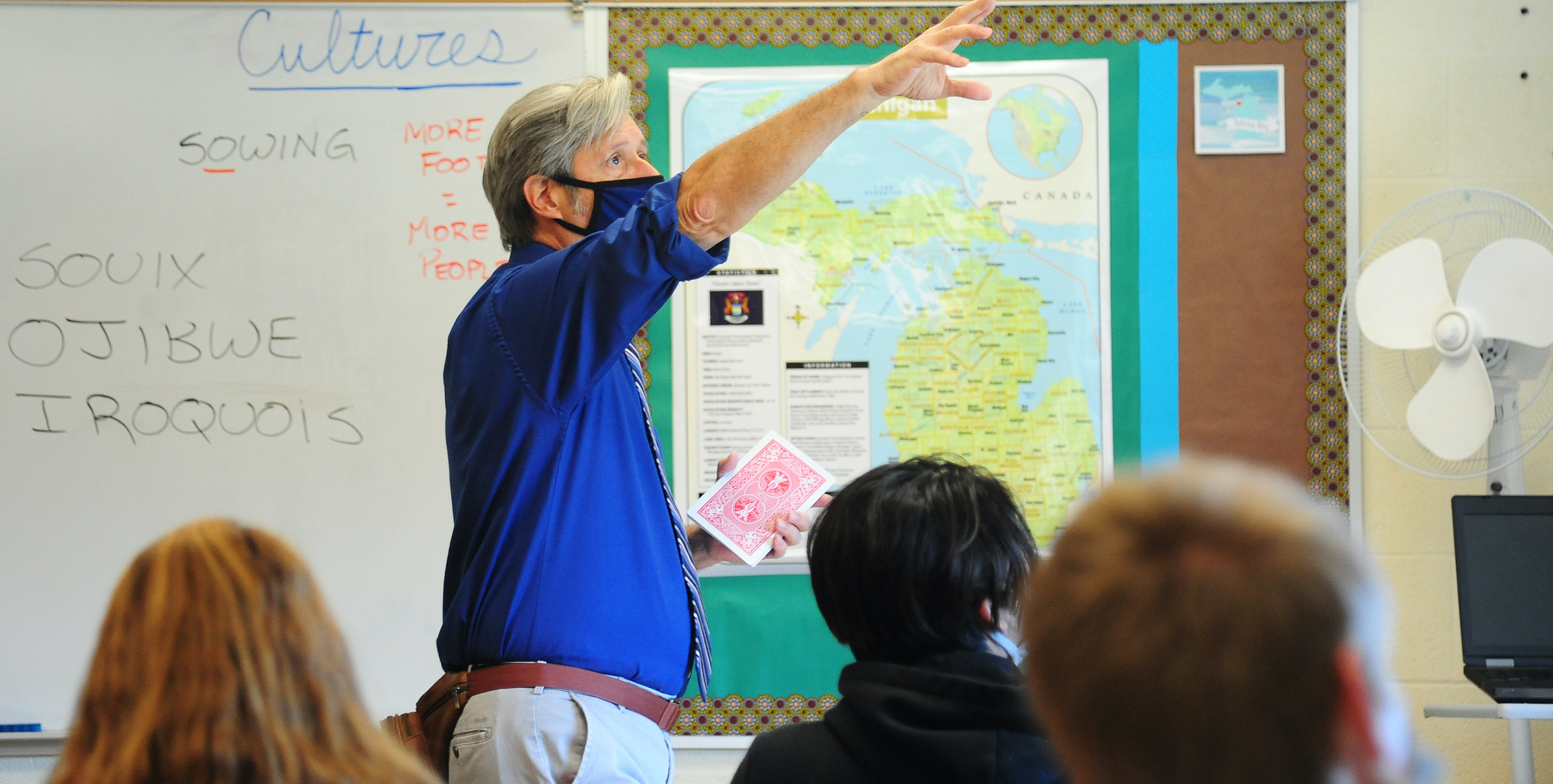
Amidst County's Most Diverse School District, Suttons Bay Adds Cultural Studies Program
By Todd VanSickle | Sept. 21, 2020
With a Native American reservation and a population of seasonal migrant workers, Suttons Bay Public Schools are considerably more diverse than most northern Michigan districts. And now, with help from the Grand Traverse Band of Ottawa & Chippewa Indians, the district has introduced a new cultural studies course, with teachers and administrators hopeful that it will help students understand their diverse community even more.
On a recent September morning, cultural studies instructor Scott Miller stood in front of a class of seventh and eighth graders wearing a blue matching mask, button-up shirt, Converse shoes and a brown fanny pack.
“Name three North American tribes located near Michigan,” Miller asked his students.
After not receiving an immediate response, he turned and pointed to the eraser board where the answer was already written — Sioux, Iroquois and Ojibwe. “Don’t be afraid to look around this room for the answer,” Miller said to his students, pointing to historic timelines and Native American murals on the walls.
The new cultural studies class will teach students about the past, present and future of northern Michigan's diverse cultures, utilizing state standards for social studies, history, geography and art.
“It's sort of like social studies education is having a moment,” says Suttons Bay superintendent Casey Petz, though noting the cultural studies class initiative has been in the making for years.
“We have been working with our teaching staff for some time trying to find ways to connect our kids,” Petz says. “And, in some way, elaborate the fact that we have something unique and special at Suttons Bay.”
According to publicschoolreview.com, 56 percent of the Suttons Bay high school population is white. Hispanics make up 19 percent, and Native American is 17 percent. Forty-four percent of the enrollment is minority. In the elementary school, minority enrollment is 63 percent of the student body. The Michigan state average for minorities in public schools is 34 percent.
“If you look at our demographics, we are a very diverse school district in an area that isn't necessarily known for diversity here in northern Michigan,” Petz notes. “We are a very rural county, with several villages with folks who have moved here to retire to folks who have been here for 200 years and they have a road named after them. …We have subdivisions. We have a Native American reservation. We have migrant camps. We have apartment housing. It's such an interesting mix.”
The class is designed around state standards, according to the superintendent.
“You have a certain set of things that you are expected to teach and kids are expected to learn and then we're all assessed,” Petz says. “Literally, our jobs depend on our ability to do those things to teach the state standards, and to make sure that kids exit with those core skills.”
Petz says every child in the district has a connection to the initiative; a version of it is available from elementary through middle and high school.
“Coming into this with a limited curriculum it has been a challenge for me to take a broad idea and break it up into different areas of learning,” teacher Miller says. “I am trying to come at it with as many different learning modalities as I can.”
He plans to incorporate music, art, dance and cuisine as learning tools -- though he views his most important role to be encouraging discussion.
“My major question for all grade levels, ‘Why do people live this way or that way?’” Miller says. “I want more discussions in this class and less text reading. I would rather have discussions about things that are important to them, then try to give them a preset, cookie-cutter culture class. That is not this class. This class is full of questions, full of perspectives and full discussions.”
Miller will be assisted by the school’s Indian Education Director and Title VI Director Samantha TwoCrows along with English Learner Migrant Specialist Beatriz Cruz.
The three recently introduced the cultural studies class and themselves to the public via a YouTube video. In the two-minute video, TwoCrow spoke in an Odawa dialect referred to as Anishinaabemowin, while Cruz spoke Spanish.
“I am so excited because we are going to be able to learn and work together to learn about the cultures and races that live here Michigan,” Cruz said in the video. “Together we are going to learn about the history they made in Michigan.”
TwoCrow credits the superintendent for bringing the initiative to fruition.
“In collaboration with [Petz] and so many team members here, we put together this cultural class, not just for the Native Americans, but for the entire school,” TwoCrow says. “Not only is it important to build that cultural identity for students, but it's also just as important to bring awareness and to bring community togetherness by showing who we are individually.”
TwoCrow says she is looking forward to supporting Miller in his classes, who travels with her family performing at various Pow Wows throughout the year. She is optimistic that as soon as the Covid-19 pandemic eases, she will be able to offer many resources.
“I live this life of being a Native American so I'm here to provide that authenticity,” TwoCrow adds. “I'll work with [Miller] to bring resources and hopefully at one point bring speakers into the school and do food. Anything that we can do to enrich that Native American perspective — that's going to be my job coming into the classroom.”
The initiative is funded through several sources, including general fund dollars, 2 percent funding grant from the Grand Traverse Band of Ottawa and Chippewa Indians, and federal Title VI and at-risk funding.
“If we can teach who we are and what we do and what is in our past and where we're at right now and where we might be headed into the future, that creates a level of understanding and connectivity that I think is really important for us right now,” Superintendent Petz says. “I'd want our families to know that what we're doing is pointed at our population, what makes us unique and special. That is really what we're working on here.”
CommentNational Study: Leelanau County Tops the Nation in Food Costs
Leelanau County is the most expensive county in the country for food costs, according to a recent ...
Read More >>Tuesday Filing Deadline Brings County Election Races Into Focus
Though early signs indicated a concerningly sparse field for this year’s impending Leelanau County Board of Commissioners ...
Read More >>The Latest Leelanau County Blotter & 911 Call Report
The Leelanau Ticker is back with a look at the most alarming, offbeat, or otherwise newsworthy calls ...
Read More >>Barge Owner Pleads Guilty, Gets One Year To Move Vessel
Donald Balcom, the owner of a decrepit barge that has been repeatedly abandoned at numerous points around ...
Read More >>



